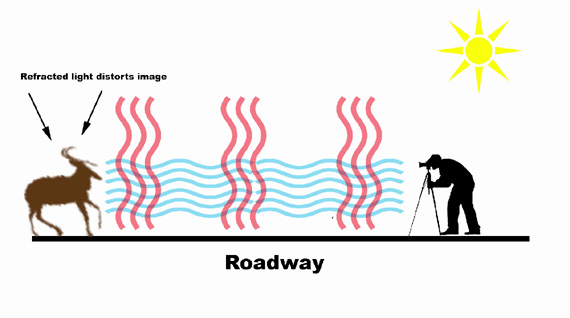If you use a long lens, you may be unaware that shooting on a hot day can decrease the quality of your images. Intrigued? Heat can cause image distortion. In this video, Steve Perry explains this issue for landscape and wildlife photographers:
You might have already experienced issues with your lens on hot days. In situations where your camera looks over a patch of land that is exposed to the sun, the result is often shimmering views through the lens, distorted proportions, and a confused auto-focusing system that finds it hard to lock focus.

Heat waves are caused by the sun heating a surface.
When the sun beats down on an exposed surface—land, water, the hood of your jeep, whatever—the resulting heat is transferred from the surface to the surrounding air. In turn, the air is heated up, and it rises, causing cooler air to descend. The difference between densities of cool air and hot air creates a shimmering effect. It does not even have to be an exceptionally warm day. This can happen anywhere and in any month. Perry cites an example where he photographed a grizzly bear when the temperature was in the upper 20s; the image was still affected.

This shot shows how heat waves can make your images “mushy”.
The problems with poor image quality and difficulty locking focus tend to worsen when you shoot subjects over greater distances. In other words, longer lenses compress the heat wave between you and the subject. This results in very soft looking images.
Though hot air can be an issue with any lens, you’re more likely to see problems if you are using a lens that is in the range of 150mm to 200mm or beyond.
The Solution
Here are some of the tips that Perry shares to counter the problems that heat causes with your photos:
- Change your position to a location where heat does not emanate from the surface as much.
- Shoot as close as possible to your subject.
- Shoot in the early morning and late afternoon light when there is less chance of encountering heat waves.
- Shoot on overcast days.

A hot car hood gives off a lot of heat, creating a heat wave and distorting your images.
- Don’t shoot from over your car hood on a sunny day!
“Just being aware that the problem exists has allowed me to avoid it on a very regular basis.”
Like This Article?
Don't Miss The Next One!
Join over 100,000 photographers of all experience levels who receive our free photography tips and articles to stay current:






Great, informative video directed at a question frequently pondered by photographers. Many believe the answer to a sharper, more detailed photo of a bird or other critter, is a longer focal length. You have correctly pointed our that it is distance to the subject that is the bigger issue with heat distortion. You can have the same problem shooting a distant mountain with a 24 mm lens. It is just a bigger problem using the longer focal length and not reducing distance to the subject. Thanks.
That makes so much sense yet I’ve never heard of this effect before. Aware now – and highly relevant in southern China
This happened to me during the 2008 presidential campaign. Obama came to Denver on a pretty cool, overcast day but I still got this type of distortion. I think what happened, was that I was shooting over a large crowd and the body heat from the people was rising up causing the distortion. I was pretty upset when I looked at all the photos of Obama and it looked like I shot through some strange window.